The Samsung 850 EVO 4TB SSD Review
by Billy Tallis on July 11, 2016 10:00 AM ESTAnandTech Storage Bench - The Destroyer
The Destroyer is an extremely long test replicating the access patterns of very IO-intensive desktop usage. A detailed breakdown can be found in this article. Like real-world usage and unlike our Iometer tests, the drives do get the occasional break that allows for some background garbage collection and flushing caches, but those idle times are limited to 25ms so that it doesn't take all week to run the test.
We quantify performance on this test by reporting the drive's average data throughput, a few data points about its latency, and the total energy used by the drive over the course of the test.
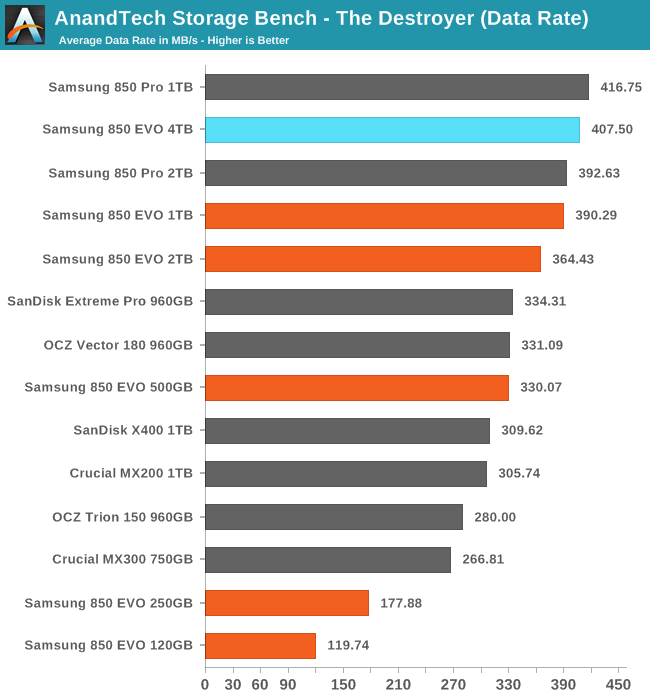
The Destroyer isn't enough to really challenge the 4TB 850 EVO, as this test doesn't write enough data to fill the drive even halfway. The 1TB 850 Pro still holds the record for the highest average data rate maintained by a SATA drive, but the 4TB EVO is closer to that than to any slower drive.
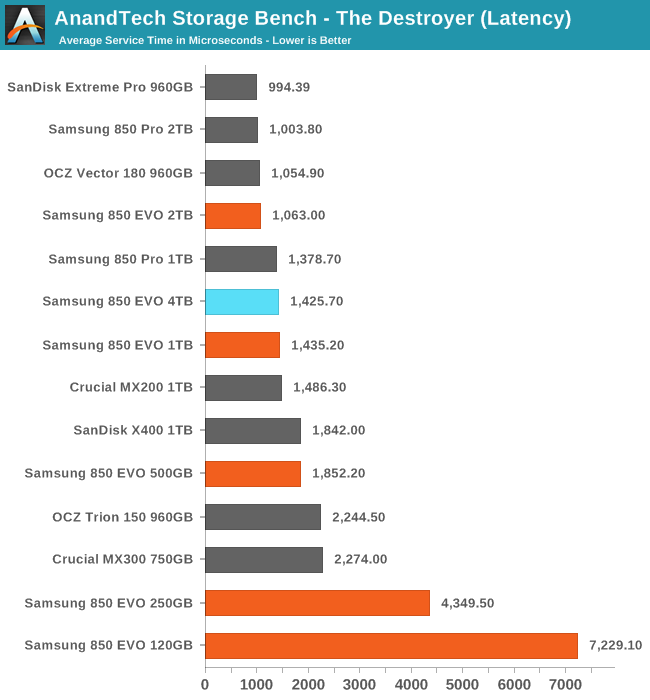
After the 2TB 850 Pro and EVO managed to tie with the top tier of drives for average service time, it is a little disappointing to see the 4TB 850 EVO only manages to match the 1TB models, but that's still high-end performance.
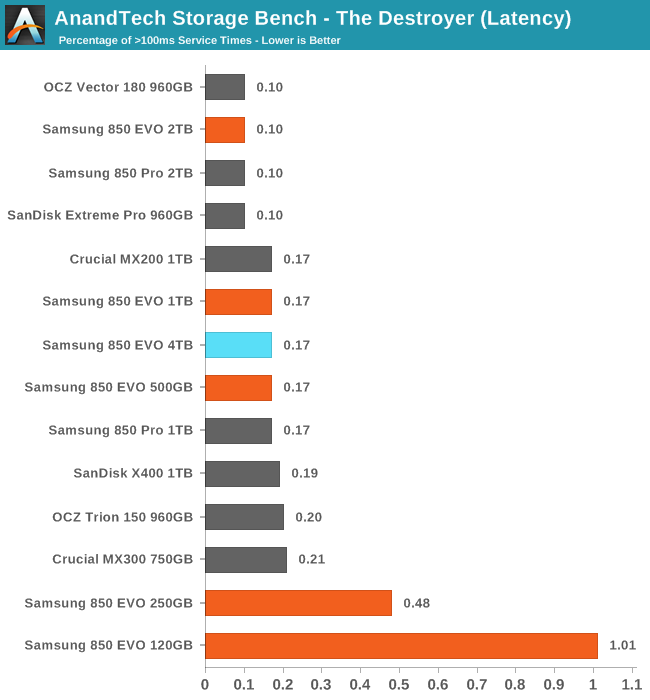
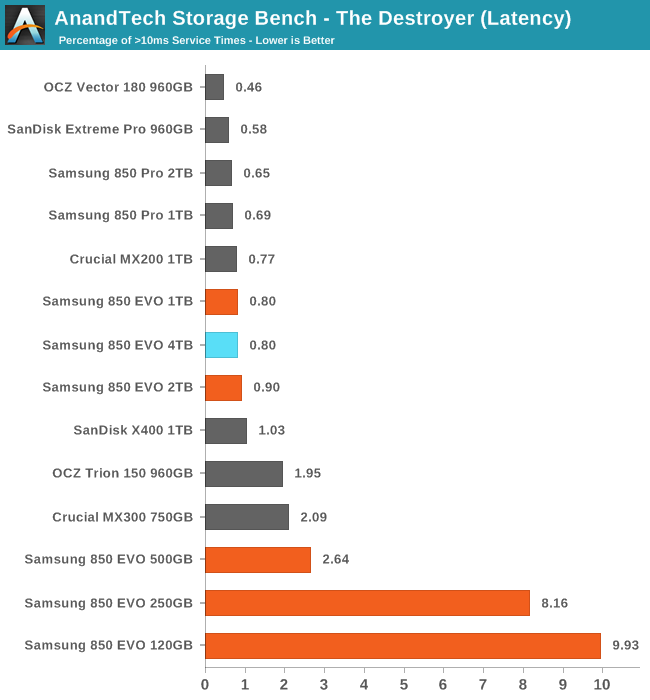
The 4TB 850 EVO has slightly more extreme latency outliers than the 2TB 850s, but at the more strict threshold of 10ms it is tied with the 1TB 850 EVO for being the best TLC drive.
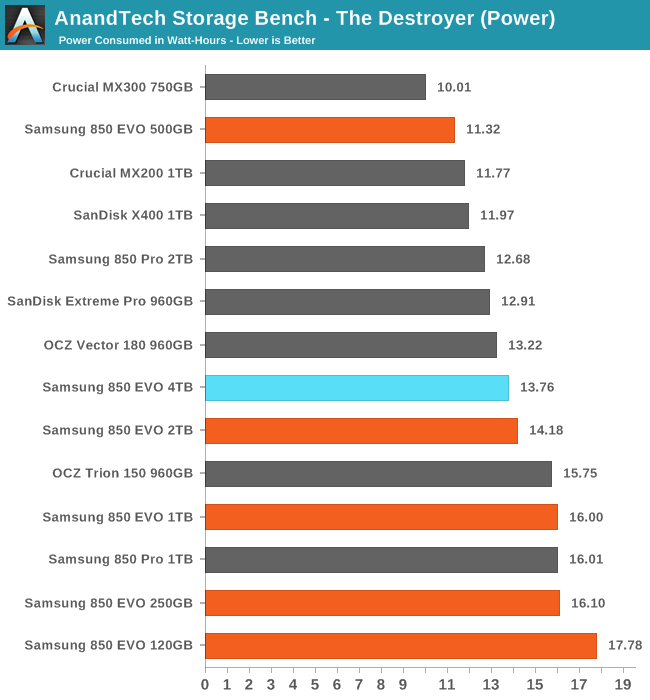
The 4TB 850 EVO brings a little more reduction in power use over the 2TB 850 EVO, which substantially cut power use relative to the 1TB model. The 4TB drive is clearly not paying any significant penalty for keeping so much flash and DRAM powered up.










145 Comments
View All Comments
SetiroN - Monday, July 11, 2016 - link
I mean I understand and agree that Samsungs are the better drives to buy at lower capacities right now, but if you needed 4TB or more you just have to be silly to spend $700 more.Let me say that again: $700.
Oxford Guy - Monday, July 11, 2016 - link
"I can't honestly think of any good reason to buy something other than samsung SSD"1) People who were burned by the very poor steady state performance (according to one professional review site) of the original 840 120 GB.
2) People who were burned by the problems with the 840 EVO and who aren't impressed by the kludgy work-around of re-writing data again and again.
3) People who haven't been impressed with generations of BS power consumption specs. It's only recently that we're now seeing ratings for read/write power consumption. Prior to that, though, there generations/years of Samsung SSDs with ".17 watt" power consumption nonsense. This was not only the only thing on their site for SSDs that used plenty of watts when working (like the 830 and 840) — consumers even advised each other in the comments in places like this to choose Samsung because of the very low power consumption (even though the 840 topped the chart here, as I recall, for consuming the most watts when writing).
But, that said, the 850 seems to be the first decent TLC SSD so I'm glad the company has made significant improvement.
Impulses - Monday, July 11, 2016 - link
I guess I got lucky, went straight from 830s to 850 EVOs & SM951, have yet to get burnt. Though to be honest, every other SSD OEM out there (including Intel) had at least one catastrophic scenario like the 840's (often worse, resulting in data loss), if not several such scenarios.I'm not completely excusing Samsung, because their handling of the situation wasn't optimal (went from trying to brush it under that rug to a kludgy fix that didn't even cover the non EVO)... But I'm also not holding it against them.
Palorim12 - Tuesday, July 12, 2016 - link
1. They released a fix it a week or two ago.2. completely fixed in April of 2015. Doesn't constantly rewrite data, the new algorithm itself fixes the read speeds and the idle write thing they have is a just in case the algorithm can't fix it.
3. Use desktops, so can't say anything about power consumption.
romrunning - Monday, July 11, 2016 - link
Sure, the *1TB* Ultra II is cheaper per GB. But show me where I can buy a 4TB Ultra II, and then you'll have an apples-to-apples comparison.ddriver - Monday, July 11, 2016 - link
Well, you can't, but you can buy 4 1TB, put them in RAID 0 and get 2 GB/sec vs 500 MB/sec from the EVO.So almost the same capacity (it is 960 GB really) at 4 times the speed (and 4 times less reliability ;) for 2/3 of the cost.
quiksilvr - Monday, July 11, 2016 - link
That is only a viable option if you have a desktop computer or a Thunderbolt external drive enclosure. An initial price of $1499 is a lot but 4TB is ridiculous. And if that price drops to $999, that would be even more bonkers. I remember the days when having just 1TB was that price. The fact that we are at 4 times the capacity for the same price and WAY better performance is nuts.TemjinGold - Monday, July 11, 2016 - link
And 4 times the headaches having to deal with the RAID setup.mapesdhs - Wednesday, July 13, 2016 - link
And the reliability issue of one device failure trashing all the data, though one could get round this by using four 2TB in RAID10 which wouldn't be so bad, but still a lot of ports, etc.Gigaplex - Monday, July 11, 2016 - link
I'd also need a RAID controller with 4 spare SATA ports.